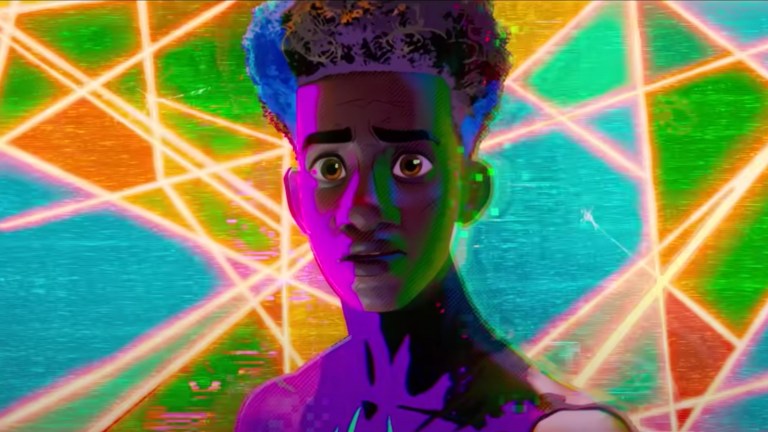Spider-Man: Across the Spider-Verse Is Beating Marvel Studios at the Multiverse Game
Spider-Man: Across the Spider-Verse looks poised to be the superhero and multiverse movie of the summer even though DC and Marvel proper are treading similar ground. Huh.

One of the constant refrains in Sony Animation’s Spider-Man: Into the Spider-Verse (2018) was that “anyone can be Spider-Man.” That might be true, but there is only one Miles Morales, and folks cannot seem to get enough of him in Spider-Man: Across the Spider-Verse.
This visually dazzling sequel to 2018’s Spider-Man: Into the Spider-Verse, which in its own day was heralded as a game-changer, is an absolutely breathtaking achievement in the superhero genre and American animation as a whole. It also has wowed audiences and critics in equal measure, earning the coveted “A+” CinemaScore from audiences surveyed by the industry pollsters, and surpassing studio expectations with a domestic opening of $120.5 million. That’s nearly quadruple what Into the Spider-Verse earned five years ago when it debuted to $35.3 million. More intriguing still, it is up over Marvel Studios’ big summer release for 2023: Guardians of the Galaxy Vol. 3, which earned $118.4 million over its first three days in North America.
In pure nickels and cents, this is a major win for Sony, which has expanded the popularity of Miles Morales and the “Spider-Verse” animated franchise by a massive amount in the last half-decade, building largely off rapturous word-of-mouth for both the 2018 film and now its sequel. Winning the Oscar for Best Animated Film in 2019—a first for Sony and a rarity for the Academy, which tends to look at only Disney and Pixar for the award—also probably didn’t hurt.
But more than awards and box office, the success of the Spider-Verse films, particularly its sequel, may be measured in just the kind of impact it is having on the culture, particularly in the current zeitgeist moment being enjoyed by Across the Spider-Verse. After all, multiverse movies have become all the rage in the 2020s, with the second biggest hit of the decade, the live-action Spider-Man; No Way Home, taking a seeming page from Into the Spider-Verse by indulging in the concept of multiple Spider-People on screen at once. Meanwhile last year’s Oscar-winner for Best Picture was the generally beloved (at least among millennials and Gen-Z moviegoers), Everything Everywhere All at Once.
And yet, when you look closer at the current state of the superhero genre, it would seem a lot of movies about caped do-gooders are following Into the Spider-Verse’s lead… but the results have so far been more checkered, at least when judging by the audience reception. Last year’s Doctor Strange in the Multiverse of Madness embraced the idea of multiple versions of familiar superheroes and villains interacting with each other, and while that film opened massively at $187.4 million (a huge upswing from the 2016 Doctor Strange’s $85 million), it also dropped like a stone in subsequent weeks, beginning with a colossal 67 percent fall-off in its second weekend, which reflected the film’s anemic “B+” CinemaScore (among the lowest in the MCU).
Meanwhile this spring’s Ant-Man and the Wasp: Quantumania saw a similar 69.9 percent drop in its second weekend despite being the film which promised to kickstart Marvel Studios’ “Phase 5” by introducing the multiverse-hopping Kang the Conqueror (Jonathan Majors), the new big bad who the entire next three years of the MCU is expected to be built around. Quantumania even ended with an entire citadel of Kang variants from across the multiverse gathering in one location to plan retribution on Ant-Man and the Avengers, setting up Avengers: The Kang Dynasty (2025) and presumably Avengers: Secret Wars (2026), two films based on comic book stories obsessed with multiverse plotting.
Marvel’s current publicity troubles related to allegations against Majors aside, it’s an open question as to whether audiences have been won over by the prospect of a three-year cycle of Marvel films built around the studio’s multiversal storytelling. Yes, No Way Home was the most popular film of Marvel’s “Phase 4,” but that movie primarily used the concept of a multiverse (or Spider-Verse) as a means to an end. It was a narrative vehicle to allow for maximum fan service, with Tobey Maguire, Andrew Garfield, and Tom Holland all appearing on screen as Spider-Man at the same time, and fighting old favorites in the genre (namely Willem Dafoe and Alfred Molina’s supervillains from the Sam Raimi/Maguire years).
Conversely, Into the Spider-Verse and Across the Spider-Verse used the concept of a multiverse to break new ground in the superhero genre. Those films embraced the abstract zaniness of comics by way of a black and white, 1940s-style “noir” Spider-Man and a literal cartoon pig in the first film, and then truly experimented in art designs and aesthetics in Across the Spider-Verse. They also explored the prospect of newcomers to the cinematic mythos like Miles Morales (Shameik Moore), Spider-Gwen (Hailee Steinfeld), and even a married, middle-aged, and fatherly Peter Parker (Jake Johnson), as opposed to one who is “still trying to do better” 20 years later. By comparison, No Way Home was another visually muted Marvel Studios effort that was content to retread the past for maximum nostalgia.
While Doctor Strange 2 certainly was more visually innovative and clever than No Way Home, with no less than Raimi himself returning to the director’s chair and introducing his penchant for horror imagery to the MCU, the film still largely used the multiverse concept to again service fans, If you are terminally online, you likely laughed out loud that the fan favorite casting for Mr. Fantastic, John Krasinski, showed up as the stretchy-man for five minutes, and that he was partnered with Patrick Stewart’s Charles Xavier (rocking the hover-chair from X-Men: The Animated Series) and Hayley Atwell as Captain Carter, a la the Disney+ animated series What If… But for the uninitiated, the inside geek baseball left some audiences rather cold.
Elsewhere, Quantumania tried to at last break new ground with the concept by bringing Loki’s Kang to a larger audience, but given the mediocre box office and audience scores for Ant-Man 3, Marvel’s first major step into a multiverse saga is off to a rocky start. That film ends up teasing the prospect of an empire of Kangs, but Across the Spider-Verse just showed audiences an HQ filled with beloved Spider-People. Hell, they even have a Spider-T-Rex.
And lest you think this piece is designed to neg Marvel, DC Studios’ own first foray into multiverse storytelling could find itself in an unenviable position by being compared to Across the Spider-Verse. Warner Bros. Discovery CEO David Zaslav and DC Studios’ new co-chair, James Gunn, have called it one of the best superhero movies of all time. While that strikes us a bit like hyperbole, the film itself is very good. It even does some interesting things with a superhero “multiverse,” albeit you wouldn’t know from the marketing which is primarily focused on taking a page out of the Spider-Man: No Way Home playbook: Remember Michael Keaton and Ben Affleck as Batman?
There is of course room for two superhero movies with similar concepts and themes. After all, the genre has rarely been accused of featuring a great diversity of narratives. Plus, No Way Home far outgrossed Into the Spider-Verse, even though the latter did roughly the same idea first (and some might argue better).
Still, things look a little trickier for The Flash since the movie is coming out a mere two weeks after Spider-Man: Across the Spider-Verse. And unlike the 2018 animated Spidey flick, audiences are showing up in droves for Across the Spider-Verse in theaters, largely based on the goodwill Into the Spider-Verse generated after being discovered by audiences on streaming and other home media. Across the Spider-Verse’s “A+” CinemaScore also seems to suggest the film is positioned to have a very leggy run across June, particularly if this week’s Transformers: Rise of the Beasts and next week’s The Flash underperform. The Flash, indeed, has the added burden of being a leftover project from a previous regime at Warner Bros., which along with its own lead actor’s controversies might inform why the film is currently tracking so low at around $70 to $80 million for its opening domestic weekend.
Across the Spider-Verse is using the same rough idea—with its titular hero traversing the multiverse—and is innovating its genre and medium, such when it has the ‘70s counterculture aesthetic of Spider-Punk (Daniel Kaluuya) mingle with Da Vinci-inspired parchment sketches, courtesy of Neil Gaiman’s underrated Marvel 1602 comic book series. When contrasted with a movie where Keaton’s Batman is still saying the same line from 34 years ago… the differences are striking.
Spider-Man: Across the Spider-Verse is now playing in theaters.
